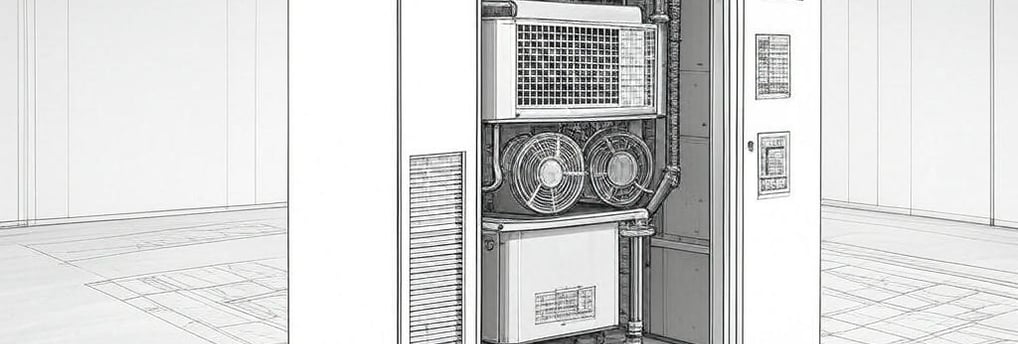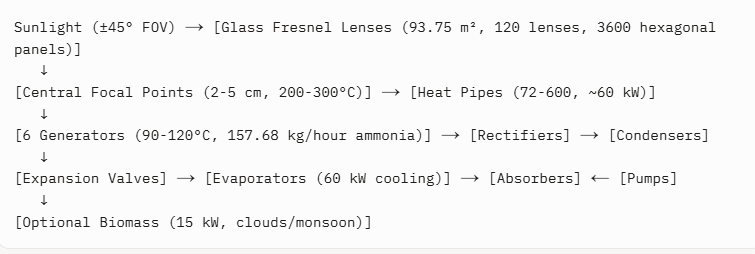How Our Solar-Powered Cooling System Works: Sustainable Comfort for Northern India Homes
Hey everyone! As heatwaves in northern India soar to 50°C, keeping homes cool is more critical than ever. Traditional ACs are pricey, rely on the grid, and harm the planet with high-GWP refrigerants. That’s why we’ve created an innovative solar-powered ammonia-water absorption chiller system to bring eco-friendly cooling to homes, from small 1-2 BHK flats in rural Rajasthan to large villas in Delhi. Available in 2-ton (7 kW) and 10-ton (35 kW) units, our system cools ~200-1000 m², dropping temperatures to a comfy 22-25°C—all while slashing emissions and energy use. Let’s break down how it works!
5/8/20243 min read


Step 1: Capturing Solar Energy with Glass Fresnel Lenses
We start by harnessing the sun’s abundant energy in northern India, where we get 5-6 kWh/m²/day of sunlight. Our semi-circular, glass-based Fresnel lenses are the stars here. These lenses, inspired by PIR motion sensors, are made of durable borosilicate glass and designed with ~30 hexagonal panels (10 cm sides, 50-100 tiny facets each). They don’t need trackers—saving us ~₹30,000 per unit—because their wide ±45° field of view captures sunlight for 6-8 hours a day.
2-Ton System: Uses 11 m² of lenses
(14 lenses, 1 m diameter each).10-Ton System: Needs 55 m² (70 lenses).
Each lens focuses sunlight 10-30x into a tiny 2-5 cm spot, reaching 200-300°C. Our glass lenses are built for India’s harsh conditions, resisting dust and heat with just a ~5% efficiency loss, and we’ve boosted their performance to 80% efficiency with special coatings. This setup generates 7 kW of heat for a 2-ton unit and 35 kW for a 10-ton unit, all from the sun!
Step 2: Transferring Heat with Heat Pipes
Next, we need to get that solar heat to our chiller. That’s where our heat pipes come in—think of them as super-efficient heat highways. We use ~70 pipes for the 2-ton system and ~350 for the 10-ton system, each made of copper and filled with a fluid like water or methanol. These pipes transfer the 200-300°C heat from the lens’s focal point to the chiller’s generator, cooling it down to a steady 90-120°C for operation. With a transfer efficiency of ~91%, we ensure almost all the solar heat powers our cooling process, delivering 7 kW or 35 kW of heat input with minimal loss.
Step 3: Driving the Cooling Cycle with Ammonia-Water
Now comes the heart of our system: the ammonia-water absorption chiller. Unlike traditional ACs that use electricity to compress refrigerants, our chiller uses heat to drive a clever cycle with ammonia (R717) and water. Here’s how it works:
Generator: The solar heat (90-120°C) warms our ammonia-water solution (30-40% ammonia), releasing ammonia vapor—~18.4 kg/hour for the 2-ton unit and ~91.98 kg/hour for the 10-ton unit.
Rectifier: We purify the ammonia vapor to ~99% for better efficiency.
Condenser: The vapor cools and condenses into liquid ammonia at 35-40°C, rejecting ~10-15 kW (2-ton) or ~50-60 kW (10-ton) of heat to the surroundings.
Evaporator: The liquid ammonia evaporates, absorbing heat from your home—7 kW for the 2-ton system (cooling
200 m²) or 35 kW for the 10-ton system (1000 m²)—bringing the temperature down to 22-25°C.Absorber: The ammonia vapor mixes back with water, rejecting another ~10-15 kW (2-ton) or ~50-60 kW (10-ton) of heat.
Pump: A small pump (~0.2-1 kW) circulates the solution back to the generator, using minimal electricity.
Our system achieves a COP of 1 (thanks to upgrades like a double-effect cycle), meaning every kW of solar heat produces 1 kW of cooling. Plus, ammonia has zero ozone depletion or global warming potential—unlike R-134a (GWP = 1430)—making it super eco-friendly.
Step 4: Cooling Your Home Sustainably
The result? Cool, comfortable homes without harming the planet! Our 2-ton unit cools ~200 m²—perfect for a 1-2 BHK—while the 10-ton unit handles ~1000 m², ideal for a large villa or small apartment cluster. We drop temperatures from a scorching 50°C to a cozy 22-25°C, even in the harshest heatwaves. During cloudy periods, output may dip ~25% (e.g., 10-ton: 26.4 kW, ~754 m²), but simple adjustments like better insulation keep things comfortable.
Why It Matters?
Our system isn’t just about cooling—it’s about sustainability:
Emissions Reduction: We cut 6-35 tons CO₂/year per unit by using ammonia (zero GWP) and solar power, saving ~8,500-42,500 kWh/year of grid electricity (7-35 tons CO₂).
Decarbonization: We power cooling with solar heat, eliminating fossil fuel use for heat and slashing grid reliance, supporting India’s net-zero goals.
Innovation: Our tracker-free lenses and ammonia chiller are a fresh take on climate tech, making cooling accessible in grid-scarce rural areas and high-demand urban centers.
Wrapping Up
Our solar-powered ammonia-water absorption chiller is revolutionizing residential cooling in northern India. By harnessing the sun with our glass Fresnel lenses, transferring heat efficiently, and using a planet-friendly cooling cycle, we’re keeping homes cool, cutting emissions, and paving the way for a sustainable future. Ready to join the planet-saving movement? Let’s make cooling green together! 😄


Legal Details
Kalusyam Tech Private Limited
CIN: U72900UP2019PTC120350
DPIIT: DIPP43906
Regd. Add: CK 43/34, GOVINDPURA CHOWK, GOVINDPURA, VARANASI, 221001
Contact Us
Get in Touch
© 2025 Kalusyam Tech Private Limited. All rights reserved.
